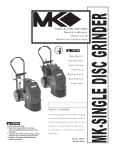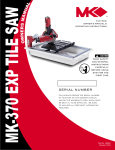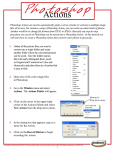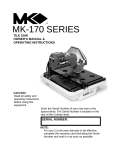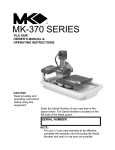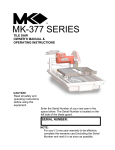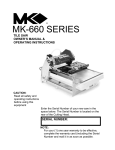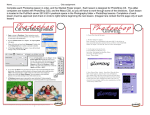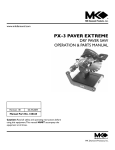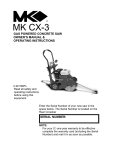Download MK DIAMOND PRODUCTS, INC 1315 STORM PARKWAY
Transcript
MK DIAMOND PRODUCTS, INC 1315 STORM PARKWAY TORRANCE, CA 90509-2803 310-539-5158 www.mkdiamond.com SAFETY INSTRUCTIONS FOR THE PX-3 PAVER SAW Congratulations on your purchase of a PX-3 Paver Saw. We are certain that you will be pleased with your purchase. MK Diamond takes pride in producing the finest construction power tools and diamond blades in the industry. Operated correctly, your PX-3 should provide you with years of service. In order to help you, we have included this manual. This owners manual contains information necessary to operate and maintain your PX-3 safely and correctly. Please take a few minutes to familiarize yourself with the PX-3 by reading and reviewing this manual. If you should have questions concerning your PX-3 , please feel free to call our friendly customer service department at: 800 421-5830 Regards, MK Diamond 2 Revision 01/04, Effective Date January 23, 2004 PX-3 TABLE OF CONTENTS SAFETY SAFETY MESSAGES _________________________________________________ 4 DAMAGE PREVENTION AND INFORMATION MESSAGES ___________________ 4 GENERAL SAFETY PRECAUTIONS AND HAZARD SYMBOLS ________________ 4 CALIFORNIA PROPOSITION 65 MESSAGE _______________________________ 6 ELECTRICAL REQUIREMENTS AND GROUNDING INSTRUCTIONS ___________ 8 SAFETY LABEL LOCATIONS __________________________________________ 10 PAVER SAW SPECIFIC WARNINGS ____________________________________ 10 PRODUCT SPECIFICATIONS _________________________________________ 11 UNPACKING, TRANSPORT, STAND and ASSEMBLY UNPACKING _______________________________________________________ 12 CONTENTS ________________________________________________________ 12 TRANSPORT _______________________________________________________ 12 ASSEMBLY ________________________________________________________ 13 SETUP, ADJUSTMENT & OPERATION SETUP ____________________________________________________________ 14 PRE-START INSPECTION ____________________________________________ 14 ADJUSTMENT & OPERATION _________________________________________ 15 CLEANUP _________________________________________________________ 17 MAINTENANCE AND TROUBLESHOOTING MAINTENANCE _____________________________________________________ 18 TROUBLESHOOTING ________________________________________________ 22 EXPLODED VIEW AND PARTS LIST EXPLODED VIEW ___________________________________________________ 23 PARTS LIST _______________________________________________________ 24 THEORY THEORY OF DIAMOND BLADES_______________________________________ 26 ACCESSORIES ACCESSORIES _____________________________________________________ 27 ORDERING & RETURN INSTRUCTIONS ORDERING INFORMATION ___________________________________________ 28 RETURN MATERIALS POLICY ________________________________________ 28 PACKAGING INSTRUCTIONS _________________________________________ 28 AUTHORIZED SERVICE CENTERS ____________________________________ 28 MK Diamond may have patents, patent applications, trade marks, copyrights of other intellectual property right covering this product in this document. © 2003 MK Diamond Products, All Rights Reserved www.mkdiamond.com PX-3 Revision 01/04, Effective Date January 23, 2004 3 SAFETY Read and follow all safety, operating and maintenance instructions. Failure to read and follow these instructions could result in injury or death to you or others. Failure to read and follow these instructions could also result in damage and/or reduced equipment life. SAFETY MESSAGES: Safety messages inform the user about potential hazards that could lead to injury, death and/or equipment damage. Each on safety message will be preceded by one of the following (3) three words that identify the severity of the message. ! DANGER Not following instructions WILL lead to DEATH or SERIOUS INJURY ! WARNING ! on CAUTION Not following instructions COULD lead to DEATH or SERIOUS INJURY Not following instructions CAN lead to injury. DAMAGE PREVENTION AND INFORMATION MESSAGES: A Damage Prevention Message is to inform the user of important information and/or instructions that could lead to equipment or other property damage if not followed. Information Messages convey information that pertains on to theonequipment being used. Each message will be preceded by the word NOTE, as in the example below. NOTE: Equipment and/or property damage may result if these instructions are not followed. on GENERAL SAFETY PRECAUTIONS ) AND HAZARD SYMBOLS: ) on Safety Precautions: (( In order to prevent injury, the following safety precautions and symbols should be followed at all times! on READ OWNERS MANUAL BEFORE USE (( (( )) this equipment, Before using )) ensure that the person operating this machine has read and understands all ofonthe instructions in the manual. Precaution is the best insurance against accidents. Read and understand all safety precautions, messages, warnings and hazard symbols. You are responsible for your own safety. KEEP GUARDS IN PLACE )) (( Adhere to safety guidelines: ANSI American National Standards Institute, OHSA, or local Regulations. Never operate the saw with out the guards in place! ) REMOVE ADJUSTING KEYS AND))WRENCHES ) (( (( Form a habit of checking to see that keys and adjusting wrenches are removed from the power tool before it is turned on. )) KEEP WORK AREA CLEAN (( Cluttered work areas and benches invite accidents. DO NOT USE IN DANGEROUS PLACES )) (( Do not use power tools in damp or wet locations nor expose them to rain. Always keep the work area well lighted. KEEP CHILDREN AWAY All visitors and children should be kept a safe distance from work area. 4 Revision 01/04, Effective Date January 23, 2004 PX-3 )) SAFETY (( on (( )) MAKE THE WORKSHOP KID PROOF on Make the workshops kid proof by using padlocks, master switches or by removing starter keys. (( )) DO NOT FORCE THE TOOL A power tool will do a job better and safer operating at the rate for which it was designed. on )) USE THE RIGHT TOOL (( Do not force a tool or an attachment, to do a job that it was not designed to do. on PROPER EXTENSION CORD USE THE (( on If using an extension cord make sure it is in good condition first. When using an extension cord, be sure to use one heavy enough to )) carry the electrical current your product will draw. An undersized extension cordon will cause a drop in line voltage that will result in a loss of power and overheating. TABLE 1, Page 9 shows on the correct AWG size to use depending on cord length and nameplate ampere rating. If in doubt, use the next heavier gage. The smaller the gage number, the heavier the cord. USE PROPER APPAREL )) (( on wear loose clothing, gloves, neckties, rings, bracelets, or other jewelry that may be caught in Do not on moving parts. Non-slip footwear is recommended. Wear protective hair covering to contain long hair. ALWAYS USE SAFETY GLASSES )) (( Safety glasses should always be worn when working around power tools. In addition, a face, dust mask or respirator should be worn if a cutting operation is dusty. Everyday eyeglasses only have impact resistant lenses and may not prevent eye injury-they are NOT safety glasses. )) )) (( SECURE WORK (( Clamps or a vise should be used to hold work whenever practical. Keeping your hands free to operate a power tool is safer. )) (( DO NOT OVERREACH )) (( Keep proper footing and balance at all times by not overreaching. MAINTAIN TOOLS WITH CARE )) (( Keep tools clean for the best and safest performance. Always follow maintenance instructions for lubricating, and when changing accessories. DISCONNECT TOOLS )) (( Power tools should always be disconnected before servicing or when changing accessories, such as blades, bits, cutters, and the like. REDUCE THE RISK OF UNINTENTIONAL START on PX-3 Make sure the ON/OFF switch is in the OFF position before plugging in a power tool. Revision 01/04, Effective Date January 23, 2004 5 on )) (( SAFETY on USE RECOMMENDED ACCESSORIES )) (( Consult the owner’s manual for recommended accessories. Using improper accessories may increase the risk of personal or by-stander injury. (( )) NEVER STAND ON THE TOOL Serious injury could occur if a power tool is tipped, or if a cutting tool is unintentionally contacted. CHECK FOR DAMAGED PARTS (( Before using a power tool, check for damaged parts. A guard or any other part that is damaged should be carefully checked to determine it would operate properly and perform its intended function. Always )) check moving parts for proper alignment or binding. Check for broken parts and mountings and all other conditions that may affect the operation of the power tool. A guard, or any damaged part, should be properly repaired or replaced. DIRECTION OF FEED )) (( Always feed work into a blade or cutter against the direction of rotation. A blade or cutter should always be installed such that rotation is in the direction of the arrow imprinted on the side of the blade or cutter. NEVER LEAVE A TOOL UNATTENDED TURN POWER OFF - Do not leave a tool until it comes to a complete stop. Always turn a power tool OFF when leaving the work area, or, when a cut is finished. CALIFORNIA PROPOSITION 65 MESSAGE: ! WARNING Some dust created by power sanding, sawing, grinding, drilling, and other construction activities contain chemicals known [to the State of California] to cause cancer, birth defects or other reproductive harm. Some examples of these chemicals are: • Lead, from lead-based paints • Crystalline silica, from bricks and cement and other masonry products and • Arsenic and chromium, from chemically treated lumber For further information, consult the following sources: http://www.osha-slc.gov/sltc/silicarystalline/index.html http://www.oehha.org/prop65/out_of_date/6022kLstA.html Your risk from these exposures varies depending on how often you do this type of work. To reduce your exposure to these chemicals, work in a well-ventilated area, and work with approved safety equipment, such as those dust masks that are specially designed to filter out microscopic particles. 6 Revision 01/04, Effective Date January 23, 2004 PX-3 SAFETY (( )) Hazard Symbols: Electrical Shock! )) Never touch electrical wires or components while the engine is running. They can be sources of electrical shock which could cause severe injury or burns. (( on Rotating Parts! (( )) clothing away from all moving parts to prevent injury. Never operate the Keep hands, feet, hair, and engine with covers, shrouds, or guards removed. Over Speed! (( )) Never tamper with the governor components or settings to increase the maximum speed. Severe personal injury and damage to the engine or equipment can result if operated at speeds above maximum. ! WARNING Sawing and drilling generates dust. Excessive airborne particles may cause irritation to eyes, skin and respiratory tract. To avoid breathing impairment, always employ dust controls and protection suitable to the material being sawed or drilled; See OSHA (29 CFR Part 1910.1200). Diamond Blades improperly used are dangerous. Comply with American National Standards Institute Safety Code, B7.1 and, Occupational Safety and Health Act covering Speed, Safety Guards, Flanges, Mounting Procedures, General Operating Rules, Handling, Storage and General Machine Conditions PX-3 Revision 01/04, Effective Date January 23, 2004 7 SAFETY ELECTRICAL REQUIREMENTS AND GROUNDING INSTRUCTIONS: In order to prevent potential electrical shock and injury, the following electrical safety precautions and symbols should be followed at all times! ! WARNING In case of a malfunction or breakdown, grounding provides a path of least resistance for electric current to reduce the risk of electric shock. This tool is equipped with an electric cord having an equipmentgrounding conductor and a grounding plug. The plug must be plugged into a matching outlet that is properly installed and grounded in accordance with all local codes and ordinances. • Do not modify the plug provided – if it will not fit the outlet; have the proper outlet installed by a qualified electrician • Improper connections of the equipment-grounding conductor can result in a risk of electric shock. The equipment-grounding conductor is the insulated conductor that has an outer surface that is green, with or without yellow stripes. If repair or replacement of the electric cord or plug is necessary, do not connect the equipment-grounding conductor to a live terminal • Check with a qualified electrician or service personnel if the grounding instructions are not completely understood, or if in doubt as to whether the tool is properly grounded • Use only 3-wire extension cords that have 3-prong grounding plugs and 3-pole receptacles that accept the tool’s plug • Repair or replace a damaged or worn cord immediately ! WARNING This tool is intended for use on a circuit that has an outlet that looks like the one shown in Sketch A of Figure 1. The tool has a grounding plug that looks like the plug illustrated in Sketch A of FIGURE 1. A temporary adapter, which looks like the adapter illustrated in sketches B and C, may be used to connect this plug to a 2-pole receptacle as shown in Sketch B, if a properly grounded outlet is not available. The temporary adapter should be used only until a properly grounded outlet can be installed by a qualified electrician. The green-colored rigid ear, lug, and the like, extending from the adapter, must be connected to a permanent ground such as a properly grounded outlet box. NOTE: Use of a temporary adapter is not permitted in Canada FIGURE 1 ! WARNING To reduce the risk of electrocution, keep all connections dry and off the ground. Use only extensions cords that are intended for outdoor use. These extension cords are marked “Acceptable for use with outdoor appliances; store indoors while not in use.” Use only extension cords having an electrical rating not less than the rating of the product. Do not use damaged extension cords. Examine extension cords before using and replace if damaged. Do not abuse extension cords and do not yank on any cord to disconnect. Keep cords away from heat and sharp edges. Always disconnect the extension cord from the receptacle before disconnection the product form the extension cord. 8 Revision 01/04, Effective Date January 23, 2004 PX-3 SAFETY ! WARNING Use of under size extension cords result in low voltage to the motor that can result in motor burnout and premature failure. MK Diamond warns that equipment returned to us showing signs of being run in a low voltage condition, through the use of undersized extension cords will be repaired or replaced totally at the customers expense. There will be no warranty claim. To choose the proper extension cord, • Locate the length of extension cord needed in TABLE 1 below. • Once the proper length is found, move down the column to obtain the correct AWG size required for that length of extension cord. Extension Cord Minimum Gage for Length Volts Total Length of Cord in Feet 120 V 25 ft. 50 ft. 100 ft. 150 ft. AWG AWG AWG AWG 14 12 Not Recommended TABLE 1 PX-3 Revision 01/04, Effective Date January 23, 2004 9 SAFETY SAFETY LABEL LOCATIONS Safety labels are located according to TABLE 2 below. The labels contain important safety information. Please read the information contained on each safety label. These labels are considered a permanent part of your saw. If a label comes off or becomes hard to read, contact MK Diamond or your dealer for a replacement Item Description Part No. 1 Proposition 65 Warning Label 158322 2 Extension Cord Warning Label 155672 3 Safety Caution Label 155576 TABLE 2: SAFETY LABEL LOCATIONS 3 2 1 PAVER SAW SPECIFIC WARNINGS: ! WARNING Wear eye protection. Disconnect saw before servicing, when changing cutting blades, and cleaning. Replace damaged cutting blade before operating. 10 Revision 01/04, Effective Date January 23, 2004 PX-3 SAFETY PRODUCT SPECIFICATIONS The PX-3 is a versatile lightweight, dry, masonry saw. Operated and used according to this manual, the PX-3 will provide years of dependable service. General Description The PX-3 Paver Xtreme is engineered as a 14” dry saw, consisting of a powerful 115v motor in a hard plastic case. The saw has a five (5) inch cutting depth. Motor Specifications Motor specifications for the PX-3 are listed in TABLE 3 below. Voltage Overall Amperage Frequency RPM 115V 13 A 60Hz 3500 rpm Table 3 Blade Capacity: The PX-3 uses a specially designed 14-inch diameter segmented dry MK Diamond blade with a 0.110 in. cutting width. Paver Types: The PX-3 can cut a variety of masonry types including slump stone block, wall brick, paver brick, roofing tile, marble, granite, decorative rock, or almost any other non-ferrous material. Lockable Trigger Switch: The PX-3 is designed with a lockable trigger-operating switch in the handle to allow for ease of operation. Removable Motor Air Filter The PX-3 is designed with an easy clean motor air filter to extend the life of the motor. Replaceable Motor Brushes: The PX-3 is designed with replaceable motor brushes to extend operating life. Dust Collector: The PX-3 is designed with a Dust Collector nozzle that can be used to remove dust from the Cutting Area, using your shop vacuum’s 2-1/2 inch diameter hose. NOTE: The PX-3 is not designed to cut plastic or ferrous (metals) material. PX-3 Revision 01/04, Effective Date January 23, 2004 11 UNPACKING, TRANSPORT, STAND and ASSEMBLY UNPACKING Your PX-3 has been shipped from the factory thoroughly inspected. Only minimal assembly is required. If not already done, remove the PX-3 from the carton and place it on a flat surface. Remove strapping. Remove the accessories box from the main carton and place along side the PX-3. Note: The Owners Manual is in the accessories box. CONTENTS In the PX-3 packaging containers you will find: • PX-3 Dry Paver Saw • One Blade Wrench • One 14 inch Segmented Dry Diamond Blade (or Segmented Block Blade) • One Shaft Wrench • One Replacement Motor Air Filter • One Owner’s Manual • One Dust Nozzle • One Warranty Card PX-3 Segmented Dry Diamond Blade Replacement Motor Air Filter Dust Nozzle Blade Wrench Shaft Wrench Owner's Manual Warranty Card TRANSPORT: ! CAUTION 1. The PX-3 weighs approximately thirty five (35) pounds, making transport easy. 2. Always observe safe lifting practices when lifting the PX-3 NOTE: Lock the Cutting Head in the DOWN position using the Locking Pin when transporting the PX-3 Due to its lightweight construction, the PX-3 is designed to be carried by the durable aluminum frame. Simply lock the spring assisted cutting head in the DOWN position, grasp the frame by the lower front and upper back cross members, then lift and transport the PX-3 to the desired work location. Cutting Head Lift Points 12 Revision 01/04, Effective Date January 23, 2004 PX-3 UNPACKING, TRANSPORT, UNIVERSAL STAND and ASSEMBLY ASSEMBLY: Follow the assembly instructions to prepare your PX-3 for operation. 1. Diamond Blade Installation NOTE: When installing the Retaining Screw, do not "cross-thread" and DO NOT over tighten the screw. (A) Identify Blade Retaining Screw and Outer Flange. (B) Remove Blade Retaining Screw and Outer Flange. (C) Install and seat Blade –verify rotation. (D) Install Blade Retaining Screw and Outer Flange – tighten. 2. Dust Nozzle The PX-3 Dust Nozzle assists on the removal of dust and debris from the cutting area. Its shape is designed so it directs the flow of these particles to the shop vac hose (NOT INCLUDED). The hose required is a 2-1/2" in diameter. Connect the hose from your shop vac (NOT INCLUDED) to the Dust Collector Outlet located at the rear of the PX-3 Cutting Area. Dust Nozzle PX-3 Revision 01/04, Effective Date January 23, 2004 Attach Dust Nozzle with Shoulder Thumb Screw and Washer Nut 13 SETUP, ADJUSTMENT & OPERATION SETUP: ! CAUTION • • • Before powering or starting, check for damage that could prevent this equipment from proper operation or performing its intended function. Check for binding and alignment of moving parts. Check for damaged, broken, or missing parts. Verify the trigger switch-locking button is in the RELEASE position. Before connecting the PX-3 to a power supply, be sure the voltage, cycle and phase of the job site power source meet the following requirements: VOLTAGE 115V CYCLE 60Hz PHASE 1-phase TABLE 3 • • If using an extension power cord, make sure the length and wire gauge corresponds to the requirements listed in TABLE 1 on page 9 . An extension power cord that is too small in wire gauge (diameter), or too long in length, will cause the motor to overheat and could cause premature failure. Do not cover the motor vents. This could lead to motor overheating. Portable Generator: If using a portable generator to provide power, ensure the generator meets the following minimum requirements: 8kW 120/240 66.7/33.3 Amps Single Phase PRE-START INSPECTION The pre-start inspection should be performed before beginning any job. NOTE: In order to avoid breaker tripping, a 20-amp circuit breaker should be used. ! CAUTION If the Diamond Blade shows signs of fatigue cracking, replace the Blade before starting work. (See Diamond Blade Change-Out section on Page ) 1. Inspect the Blade for damage. Verify the Blade is correct for the material being cut. 2. Inspect the PX-3 for damage. 3. Inspect the Motor Air Filter for cleanliness. 4. Verify the Trigger Switch is unlocked. 5. Plug the Power Cord into a power source. 3 4 5 2 14 1 Revision 01/04, Effective Date January 23, 2004 PX-3 SETUP, ADJUSTMENT & OPERATION ADJUSTMENT & OPERATION Chop Cutting: A chop cut is performed by cutting completely through an object in one pass. The following section describes the correct procedure for performing a chop cut. 1. Position the Back Stop for a cross cut or rip cut. 2. Position the work against back stop. 3. Depress the Trigger Switch to start. Lower the Cutting Head to begin cutting. 4. Continue lowering the Cutting Head until the cut is complete. 5. When cutting is complete, raise the Cutting Head and release the Trigger Switch. CAUTION Allow the Blade to stop moving before removing work ! 6. Remove work from the cutting area. Cross Cutting: Back Stop in Forward position for Cross Cut Position work against back stop and perform the Cut Loose knob Loose wingnut located underneath the table Position Back Stop in Backward Location and thighten both the knob and wing nut Position work against back stop as shown and perform the cut Rip Cutting: PX-3 Revision 01/04, Effective Date January 23, 2004 15 SETUP, ADJUSTMENT & OPERATION Angle Cutting: Angle cuts are performed using the chop cut method. For angle cuts the Adjustable Back Stop is removed and repositioned. The following section describes the correct procedure for performing an angle cut. 1. Remove and position the Adjustable Back Stop. 2. Position the Back Stop for an angle cut. 3. Position the work below the Cutting Head. 4. Depress the Trigger Switch to start. Lower the Cutting Head to begin cutting. 5. Continue lowering the Cutting Head until the cut is complete. 6. When cutting is complete, raise the Cutting Head and release the Trigger Switch. ! CAUTION Allow the Blade to stop moving before removing work 7. Remove work from the cutting area. (A) Loose the knob (C) Now the back stop is ready 16 (B) Pivot the back stop to the desired angle (D) Place work against the back stop and perform the cut Revision 01/04, Effective Date January 23, 2004 PX-3 SETUP, ADJUSTMENT & OPERATION CLEANUP Clean the Air Filter and PX-3 surfaces after each use. The following section describes the correct procedure for cleaning your PX-3. 1. Unplug the PX-3 from its power source. 2. Remove the Motor Filter Cap. The Filter Cap pops on and off without removing the retaining screws. 3. Clean the Filter by removing it from the Filter Cap and tapping it on a hard surface, or use compressed air. ! CAUTION Always wear eye protection when using compressed air. 4. Reinstall Filter into Filter Cap and replace it on the PX3 Motor. 5. Clean the remainder of the PX-3 by wiping its surfaces with a clean cloth. PX-3 (A) Unplug the PX-3 from Power Source (B) Remove Motor Filter Cap (C) Remove Filter (D) Clean up Filter by tapping it on a hard surface or use compressed air. (E) Reinstall Filter into Filter Cap and place them back on to the PX-3 unit (E) Clean the remainder of the PX-3 Revision 01/04, Effective Date January 23, 2004 17 MAINTENANCE AND TROUBLESHOOTING MAINTENANCE General Maintenance It is important to lubricate the Cutting Head Torsion Spring after each use. Use light oil such as WD-40 or 3-in-1 when lubricating parts. Lubricate Torsion Spring Monthly Maintenance: The following maintenance should be performed Monthly. Items should be inspected as described below. (A) Clean and inspect the Inner Flange and Motor Shaft 18 (B) Clean the Blade Retaining Screw Revision 01/04, Effective Date January 23, 2004 PX-3 MAINTENANCE AND TROUBLESHOOTING BLADE DRESSING Like most cutting instruments, a Diamond Blade performs best when it is dressed. Over time and use, diamonds on the outer edge will become smooth or “glazed” over. This will reduce grinding efficiency and may cause the blade to “wander” or bend, giving the illusion of an alignment problem. When this occurs, the blade will need to be dressed. The diamond blade can be dressed using the MK Dressing Stick (part number 152792) and by following the steps below. 1. 2. 3. 4. Set up the PX-3 for operation. Position the Back Stop to accommodate the Dressing Stick. Hold the Dressing Stick in position and depress the Trigger to start. Lock if desired. Lower the Cutting Head while pushing the Dressing Stick into the Blade. ! CAUTION Allow the Blade to stop moving before removing work 5. Repeat the cut stroke eight (8) times. 6. When the Blade is dressed, release the Trigger Switch and raise the Cutting Head. Allow Blade to stop moving before removing the Dressing Stick. (A) Set up the PX-3 for operation PX-3 (B) Position the Back Stop to accomodate the Dressing Stick Revision 01/04, Effective Date January 23, 2004 (C) Place Dressing Stick and perform cut, repeat cut eight (8) times 19 MAINTENANCE AND TROUBLESHOOTING DIAMOND BLADE CHANGE OUT Change the Diamond Blade when it becomes worn, cracked, or damaged. The following section describes the correct procedure for changing out the Diamond Blade. ! WARNING Disconnect the tool before servicing and when changing accessories, such as blades, bits, cutters, and the like. (A) Unplug the PX-3 from its Power Source (B) Remove Retaining Nut and Outer Flange (D) Install the Diamond Blade onto Blade Shaft. Ensure that it is seated properly on the Flange. 20 (C) Remove Diamond Blade from Blade Shaft (E) Install the Retaining Nut and Outer Flange and then tighten using the Blade and Shaft Wrenches Revision 01/04, Effective Date January 23, 2004 PX-3 MAINTENANCE AND TROUBLESHOOTING MOTOR BRUSH CHANGE-OUT ! WARNING Disconnect the tool before servicing and when changing accessories, such as blades, bits, cutters, and the like. 1. Unplug the PX-3 from its power source and set it up for operation (See Setup, Adjustment and Operation) One on either side of motor (A) Locate and remove one Motor Cap Brush (B) Remove the Motor Brush. Clean the Brush Housing (C) Align and install the new Motor Brush NOTE: When installing Motor Brushes, care must be teken to ensure the Spring End is straight before installing the Motor Brush Cap. (D) Install the Motor Brush Cap PX-3 (E) Change the second Motor Brush by repeating steps (A) to (D) Revision 01/04, Effective Date January 23, 2004 21 MAINTENANCE AND TROUBLESHOOTING TROUBLESHOOTING ! WARNING Verify the Lockable Switch is unlocked and the saw is disconnected from the power source before performing any troubleshooting procedure. MOTOR STOPS TURNING If the PX-3 Motor should stop turning, perform the following troubleshooting steps: 1. Verify all power cords and plugs are fully connected. 2. Verify the circuit breaker is 20 AMP or greater. 3. Verify the circuit breaker is not tripped. Reset if necessary. 4. Verify the source voltage is 115 volts. 5. If the Motor is still not turning after performing these troubleshooting steps, return your PX-3 to MK Diamond for repair. BLADE WILL NOT CUT PROPERLY If the PX-3 Blade does not cut properly, perform the following troubleshooting steps: (A) Check for Smoothness or “Glazing” (Dress blade if needed) (B) Check for proper rotation (D) Verify the blade is correct for the material being used. (use only the PX-3 Diamond Blades) 22 (C) Ensure the Blade Core is not bent and Arbor is not out of round (E) If the Blade is still not cutting properly, contact MK at (800) 262-1575 Revision 01/04, Effective Date January 23, 2004 PX-3 EXPLODED VIEW AND PARTS LIST PX-3 EXPLODED VIEW PX-3 Revision 01/04, Effective Date January 23, 2004 23 PX-3 PARTS LIST PARTS LIST: 24 Item A A1 A2 A3 A4 A5 A6 A7 A8 A9 A10 A11 A12 A13 A14 A15 Description Assembly, Frame Casting, Frame, Right (comp) Casting, Frame, Left (comp) Support, Horizontal Frame Tube Connector, 1⁄4-20 Screw, 1⁄4-20 x 2” Hex Head Cap Washer, 1⁄4 SAE Flat Washer, 1⁄4 Split Lock Drive Stud, Round Head Grooved #16 (1⁄4) x 1⁄2 Bumper w/ Washer, �1.0 (foot) Screw, #8-32 x 1 Pan Head Phillips Washer, #8 Split Lock Nut, Hex #8-32 Label, Adhesive “PX3” Label, Prop 65 Warning Label, Extension Cord Warning Qty 1 1 1 2 4 4 4 4 2 4 4 4 4 1 1 1 MK p/n n/a 160246 160248 160249 157930 158282 151915 152591 158071 160418 160446 160447 153549 160419 158322 155672 B B1 B2 B2A B3 B4 B5 B6 B7 B8 B9 B10 B11 Assembly, Cutting Head Assembly, Arm w/ Motor & Handle Wrench, Blade Nut, 14mm Wrench, Blade Shaft Flange, Outer Blade (stamped) Flange, Inner Blade (turned) Screw, M10-1.5 x 20mm Hex Flange (blade retaining) Cap, Motor Cap, Motor Filter Spacer Pin, Cap Screw Element, Filter Screw #8 x 1 1⁄2, Combo Head Pan, Self Tapping Label, Safety Caution 1 1 1 1 1 1 1 1 1 2 1 2 1 n/a 160251 158406 158110 158105 158106 158107 157877 157878 157879 157729 158157 155576 C C1 C2 C3 C4 C5 Assembly, Blade Guard Casting, Blade Guard (comp) Screw, M6-1 x 20mm Hex Head Cap Washer, M6 Split Lock Decal, Adhesive “Paver Xtreme” Tag, Serial 1 1 4 4 1 1 n/a 160258 158158 158159 160420 158096 D D1 D2 D3 D4 D5 D6 D7 D8 D9 Assembly, Pivot Clamp Casting, Pivot Clamp (comp) Screw, 1⁄4-20 x 1 1⁄2 Socket Hd. Cap Pin, Pivot � .625 x 5.6 Screw, Set 1⁄4-20 x 1⁄4 Cup Point Spring, Torsion Stop Block Screw, 1⁄4-20 x 3/4, Socket Head Cap Pin, Grooved Dowel �5/16 x 1 1⁄4 Lock, Cutting Head 1 1 2 1 1 1 1 1 1 1 n/a 160358 154683 157645 157528 160252 158226 152587 160458 160460 Revision 01/04, Effective Date January 23, 2004 PX-3 PX-3 PARTS LIST (cont...) E E1 E2 E3 E4 E5 E6 E7 E8 E9 E10 E11 PX-3 Assembly, Table Table (comp) w/ Plastic Over Mold Screw, 5/16-18 x 3⁄4 Hex Head Cap Washer, 5/16 SAE Flat Washer, 5/16 Split Lock Backstop, Table Screw, 3/8 x 1⁄2 Socket Head Shoulder, 5/16-18 x 1.0 Nut, Wing Nylok 5/16-18 Washer, 3/8 SAE Flat Washer, 5/16 SAE Flat Knob, 3 Prong 3/8-16 x 1 Washer, 3/8 Split Lock 1 1 4 4 4 1 1 1 2 1 1 1 n/a 160409 151369 151754 151747 160349 160459 151746 150923 151754 156175 150925 F F1 F2 Assembly, Packaging Carton Carton, MK-PX3 Insert, Carton 1 1 n/a 160421 G G1 G2 G3 G4 G5 Assembly, Accessory Pack Blade, 14” PX10, Segmented w/ Cooling Holes (6mm rim height) Warranty Card Sell Sheet, Tile Accessory Extra Filter Element Owners Manual, MK-PX3 1 1 1 1 1 1 n/a 160448 155037 156915 157729 160445 J J1 J2 J3 Assembly, PX3 Dust Collector Nozzle, PX3 2 1⁄2” Dust Screw, 1/4-20 x 1 Shoulder Thumb Nut, 1⁄4-20 Hex w/ Washer 1 1 1 1 n/a 160408 160461 153941 Revision 01/04, Effective Date January 23, 2004 25 THEORY THEORY OF DIAMOND BLADES Diamond blades do not really cut; they grind the material through friction. Diamond crystals, often visible at the leading edge and sides of the rim/segment, remove material by scratching out particles of hard, dense materials, or by knocking out larger particles of loosely bonded abrasive material. This process eventually cracks or fractures the diamond particle, breaking it down into smaller pieces. As a result, a diamond blade for cutting soft, abrasive material must have a hard metal matrix composition to resist this erosion long enough for the exposed diamonds to be properly utilized. Conversely, a blade for cutting a hard, non-abrasive material must have a soft bond to ensure that it will erode and expose the diamonds embedded in the matrix. These simple principles are the foundation of “controlled bond erosion”. Types of Cutting There are two basic types of cutting-Dry or Wet; however, the PX-3 is designed only for Dry Cutting. The choice of which type of blade to use depends on: • The requirements of the job • The machine/tool utilizing the diamond blade • The preference of the operator In the case of DRY cutting, the overwhelming popularity and quantity of hand-held saws and the flexible nature of MK Diamond blades to professionally handle most ceramic, masonry, stone and concrete materials, make the DRY cutting blade a very attractive tool. When using a DRY blade, the user must be aware of distinct operating practices to ensure optimum performance. DRY cutting blades require sufficient airflow about the blade to prevent overheating of the steel core. This is best accomplished by shallow, intermittent cuts of the material with periods of “free-spinning” (for several seconds) between each cut, to maximize the cooling process. 26 Revision 01/04, Effective Date January 23, 2004 PX-3 ACCESSORIES ACCESSORIES PX-3 ITEM NUMBER DESCRIPTION 1. 157957 MK-PX10, Dry Cutting 14" Segmented Blade 2. 157944 MK-PX30, Dry Cutting 14" Segmented Block Blade 3. 157729 Motor Air Filter 4. 160408 PX3 2-1/2" Dust Nozzle Revision 01/04, Effective Date January 23, 2004 27 ORDERING & RETURN INSTRUCTIONS ORDERING INFORMATION You may order MK Diamond products through your local MK Diamond distributor. When ordering direct from your Local Distributor, please have the following information ready before calling: • The Model Number of the saw • The Serial Number of the saw • Where the saw was purchased and when • The Part Number for the part(s) being ordered • The Part Description for the part(s) being ordered For ordering replacement parts you may order by calling toll free to – 800 421-5830 or 310 539-5221 and asking for Customer Service. For technical questions, call – 800 474-5594. RETURN MATERIALS POLICY To expedite the service relative to the return of a product purchased through MK Diamond, please observe the following: NOTE: When returning any product manufactured by MK Diamond, it must have been purchased within the previous twelve (12) months. • Have the Model Number of the saw • Have the Serial Number of the saw • Have the location of where the saw was purchased • Have the date when the saw was purchased • Contact Customer Service for approval to return the item(s) • Obtain a Returned Goods Number (RGA) authorizing the return • Follow the packaging instructions in the following section • Ensure your item(s) are prepaid to the destination For returned items, call toll free to – 800 421-5830 or 310 539-5221 and ask for Customer Service. For technical questions, call – 800 474-5594 or 310 257-2845. PACKAGING INSTRUCTIONS • Clean the saw before shipping • When packing, include the following: PX-3, Diamond Blade, Blade guard and Support Angle Assembly and Adjustable Cutting Guide (Other Accessories are not required) • Package the unit in its original container or one of comparable size (do not ship the unit partially exposed) • Ensure all parts are secured in the packaging to prevent moving Credit, repair or replacement of any product returned to MK Diamond is in accordance with our Standard Warranty Terms and Conditions. AUTHORIZED SERVICE CENTERS For quicker repair time, you may contact MK Diamond Customer Service, toll free, at 800 421-5830 or 310 5395221 for the Authorized Service Center closest too you or visit our web site at www.mkdiamond.com. For technical questions, call – 800 474-5594. 28 Revision 01/04, Effective Date January 23, 2004 PX-3




























